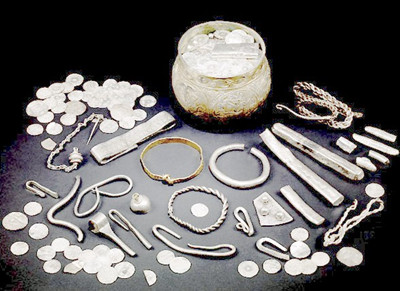The Vale of York hoard makes it clear that Viking England did indeed operate on a trans-continental scale. Here is a dirham from Samarkand, and there are other Islamic coins from central Asia. Like York, Kiev was a great Viking city, and there merchants from Iraq, Iran and Afghanistan traded their goods via Russia and the Baltic to the whole of northern Europe. In the process, the people around Kiev became very rich. An Arab merchant of the time describes them making neck-rings for their wives by melting down the gold and silver coins they'd amassed from trade:
约克郡的宝藏表明,维京人确实一度在整个欧洲大陆经商。宝藏中有一枚撒马尔罕的货币迪拉姆,也有一些来自中亚的伊斯兰货币,基辅与约克一样是维京人盘踞的重要城市,来自伊拉克、伊朗和阿富汗的商人在这里取道俄罗斯和波罗的海,将货物销往整个北欧。居住在基辅周边的人因而变得富裕。当时的一名阿拉伯商人说,这里的人熔化贸易所得的金银币,为妻子制作项圈:
"Round her neck she wears gold or silver rings; when a man amasses 10,000 dirhams, he makes his wife one ring; when he has 20,000 he makes two... and often a woman has many of these rings."
女人戴着金银项圈,男人一旦攒够一万牧迪拉姆,就会给妻子打一个项圈,两万牧就打两个…一个女人通常拥有多个项圈。
And, indeed, there's a fragment of one of these Russian rings in the hoard.
宝藏中确实有一块这种俄罗斯项圈的残片。
Although Kiev and York were both Viking cities, contact between them would only very rarely have been direct. Normally the trade route would be constructed through a series of relays, with spices and silver coins and jewellery moving north, as amber and fur moved in the other direction, and at every stage there would be a profit. But this trade route also carried the dark side of the Vikings' reputation. All through eastern Europe, the Vikings captured people to sell as slaves in the great market of Kiev-which explains why in so many European languages the words for slave and Slav are to this day still so closely connected.
基辅和约克都是维京人的城市,但它们之间几乎没有过直接交流。贸易路线上通常会有好几个中转站,商人到这里将香料、银币和珠宝运往北方,再将琥珀和皮草运往南方,每次转手都能赚上一笔。这条贸易路线也让维京人恶名远扬。他们在整个东欧到处抓人,运到基辅的奴隶市场上贩卖。也因此,在很多欧洲语言中,指代“奴隶” (slave)和“斯拉夫人”(Slav)的词语仍高度相关。
译文属可可原创,仅供学习交流使用,未经许可请勿转载













